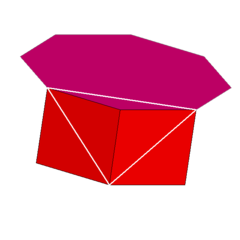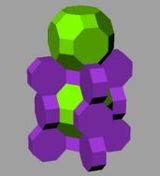Octagonal prism: Difference between revisions
Appearance
Content deleted Content added
m Reverted edits by 122.110.74.100 (talk) to last version by Tamfang |
No edit summary |
||
| Line 2: | Line 2: | ||
In [[geometry]], the '''octagonal prism''' is the sixth in an infinite set of [[Prism (geometry)|prisms]], formed by square sides and two regular [[octagon]] caps. |
In [[geometry]], the '''octagonal prism''' is the sixth in an infinite set of [[Prism (geometry)|prisms]], formed by square sides and two regular [[octagon]] caps. |
||
If faces are all regular, it is a [[semiregular polyhedron]]. |
If faces are all regular, it is a [[semiregular polyhedron]].Get Offline U Geeks |
||
== Use == |
== Use == |
||
Revision as of 02:09, 7 May 2010
| Uniform octagonal prism | |
|---|---|

| |
| Type | Prismatic uniform polyhedron |
| Elements | F = 10, E = 24, V = 16 (χ = 2) |
| Faces by sides | 8{4}+2{8} |
| Schläfli symbol | t{2,8} or {8}×{} |
| Wythoff symbol | 2 8 | 2 2 2 4 | |
| Coxeter diagrams | |
| Symmetry | D8h, [8,2], (*822), order 32 |
| Rotation group | D8, [8,2]+, (822), order 16 |
| References | U76(f) |
| Dual | Octagonal dipyramid |
| Properties | convex, zonohedron |
 Vertex figure 4.4.8 | |
In geometry, the octagonal prism is the sixth in an infinite set of prisms, formed by square sides and two regular octagon caps.
If faces are all regular, it is a semiregular polyhedron.Get Offline U Geeks
Use
In optics, octagonal prisms are used to generate flicker-free images in movie projectors.
It is an element of three uniform honeycombs:
 Truncated square prismatic honeycomb |
 Omnitruncated cubic honeycomb |
 Runcitruncated cubic honeycomb |
It is also an element of two four-dimensional uniform polychora: the omnitruncated tesseract and runcitruncated tesseract.
See also
- Set of prisms
- Triangular prism
- Cube (square-capped prism)
- Pentagonal prism
- Hexagonal prism
